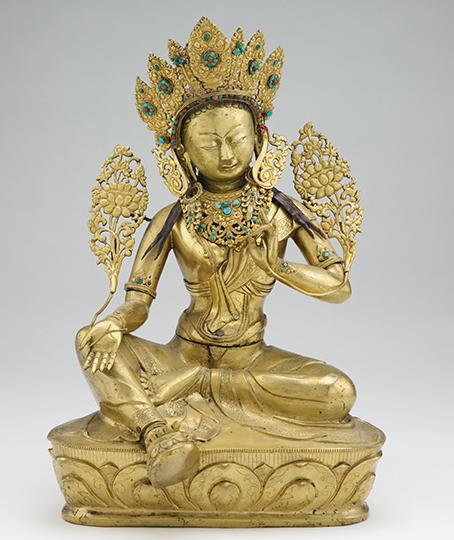In the Realm of the Buddha at the Sackler
By • November 3, 2011 0 1214

At the Sackler Gallery, a wonderful exhibition of Tibetan art, “Lama, Patron, Artist: The Great Situ Panchen,” as well as a spectacular recreation of a Tibetan altar, have just opened. Situ Panchen was an 18th-century Tibetan version of the Abbé Suger, engendering the Encampment style that incorporated aspects of Chinese landscape and color. There are incredible paintings (thangkas) and bronzes in the show that have an amazing spiritual intensity. Though Tibetan Buddhist art is very much related to Chinese and Indian Buddhist art, it is somehow able to magnify its implosiveness.
Situ Panchen was an artist himself, and for that reason he was probably very interested in shaping the art that was produced for monasteries that were part of the Karma Kagyü sect he belonged to. Because Situ Panchen was a Rimpoche (reincarnated Lama), his life is chronicled, unlike most Tibetan artists. We know that Situ Panchen began to paint even before he had been schooled in painting. At the age of 15 he undertook instruction in iconometric proportions. One of the Karmapa Lamas, the leader of the Tibetan Buddhist sect that Situ Panchen belonged to, was also a noted painter.
The Encampment style of painting had emerged in central Tibet in the late 16th century. It was called by that name because the Karmapas lived in portable encampments, or moveable monasteries. There had subsequently been political problems that had resulted in the suspension of the style. Situ Panchen re-empowered the style.
Looking at Tibetan painting as a whole, the Encampment style stands out as being freer and having an extra element of fantasy. It also uses a sweeter and softer green and has some amazing landscapes, thanks to its Chinese infusion. In the midst of skies there are conjoined figures. It is symbolic, but at some level it is also sexual. Perhaps it is truly visionary sexuality.
In the show there are also some staggering sculptures of Lamas, some of the greatest portrait sculpture ever.
The Tibetan Shrine, with the contents of the Alice S. Kandell collection, makes an enormous impact. Though viewing individual works of art is preferable in the museum manner of the Situ Panchen show, the power of the actually quite-small chapel is possibly greater. I took students of mine, not well versed in art and not at all in Tibetan art, to see the show and chapel. They had a hard time looking long at anything. They stood and gazed into the fantastic array of Bodhisattvas and Demons and Lamas for many minutes, getting it. One student remarked it was just like his (Ethiopian) church. The chapel was truly enlightening. (Through July 18.)

